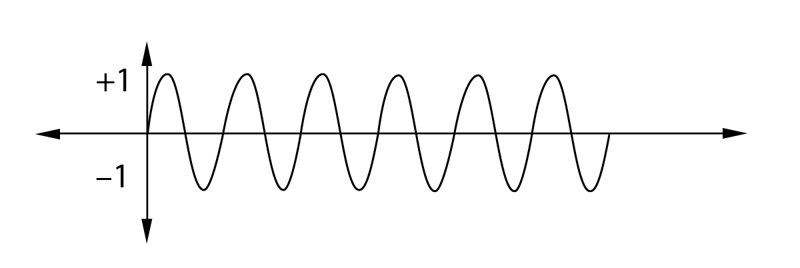In Book 1 of this series, we learnt that computers are classified according to functionality, physical size and purpose. We further classified computers according to functionality into analog, digital and hybrid. Digital computers process data that is in discrete (binary) form while analog computers process data that is continuous (analog) in nature. In this chapter, we discuss in details how digital computers represent data using a sequence of binary digits (bits).
Basic concepts
In digital computers, the user input is first converted and transmitted as electrical pulses (signals) that can be represented by two distinct states ON and OFF. The ON state may be represented by “1” and OFF state by a “0”. The sequence of ON’s and OFF’s forms electrical signals that the computer can understand. Figure 1.1 (a) shows a digital signal represented graphically as a square wave, while Figure 1.1 (b) shows an analog signal represented as a continuous sine wave.
Fig. 1.1: Digital and analog data representation
Looking at Figure 1.1 (a), you will observe that a digital signal rises suddenly to a peak amplitude of +1, holds for sometime then suddenly drops to –1 level. On the other hand an analog signal rises to +1 and falls to –1 in a continuous version (Figure 1.1 (b)). Although the two graphs look different in their appearance, notice that they repeat themselves at equal time intervals. Electrical signals or waveforms of this nature are said to be periodic. Generally, a periodic wave representing a signal can be described using the following parameters:
- Amplitude (A)
- Frequency (f)
- Periodic time (T)
Amplitude (A): This is the maximum displacement that the waveform of an electrical signal can attain. For example, the amplitude of the electrical signals in Figure 1.1 (a) and Figure 1.1 (b) is 1 (one).
Frequency (f): This is the number of cycles (360°) made by the signal in one second. It is measured in units called hertz (Hz). 1Hz is equivalent to 1 cycle/second.
Periodic time (T): This is the time taken by a signal to complete one cycle. Periodic time, T, is given by the formula
When a digital signal is to be transmitted over analog telephone cables, it has to be converted to analog form. This is done by connecting a device called a modem to the digital computer. This process of converting a digital signal to analog signal is known as modulation. On the receiving end, the incoming analog signal is converted back to digital form in a process known as demodulation; hence the acronym modem. Figure 1.2 shows how data is transmitted via the telephone line from a sending computer to a receiving computer.



